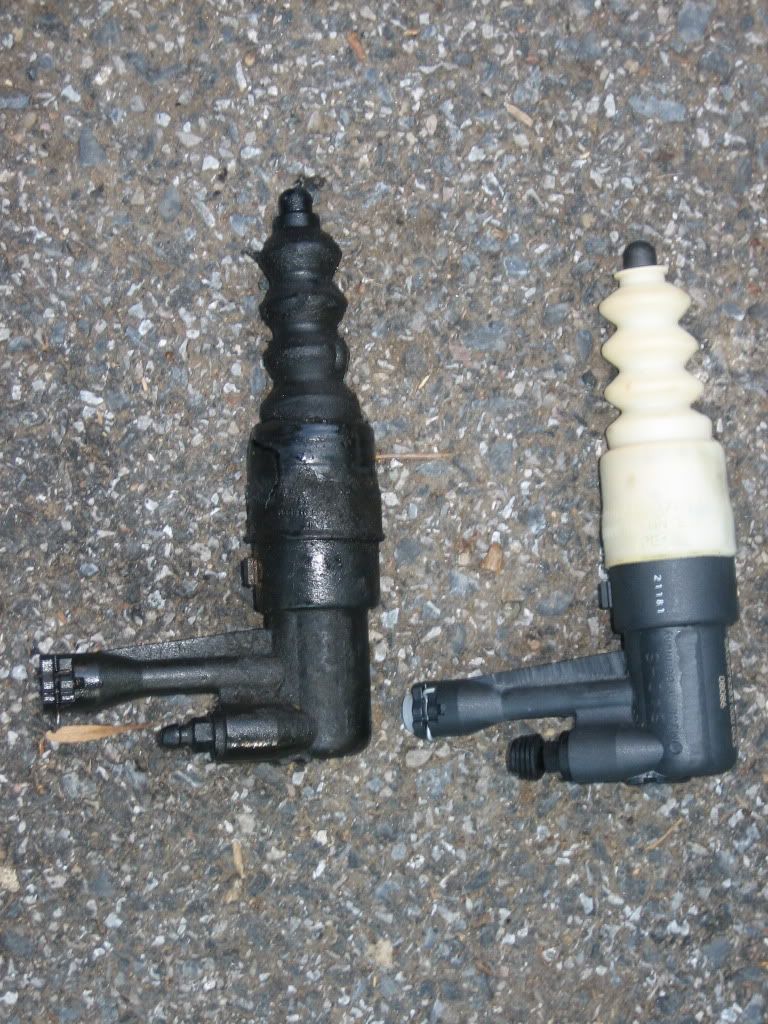So I've been following this information here from JHM on bleeding my clutch slave:
** NOTE: You usually have to crack the bleeder screw .5 to 1 full turn to get any fluid/air to come out. **
Similarly to Brakes, Clutch hydraulics (slave or master) need to be bled after being opened or when a component is replaced. Also, you always need to make sure the brake/clutch fluid reservoir is full and stays above the level of the hose that comes out the side of the reservoir, this hose is what feeds the Clutch Master Cylinder so if the level gets below this hose you will then start sucking air into the clutch hydraulics and have to start your bleeding procedure all over again.
NEW CYLINDERS OR FULLY DRAINED SYSTEMS. With all that air in there, it will just aerate the fluid and never bleed if you try the old pump it up and then hold it to the floor routine and then have someone crack the bleeder after. INSTEAD crack the bleeder FIRST, then push the pedal to the floor and hold it. Then while still holding the pedal to the floor close the bleeder. Then pull the pedal up, only once the bleeder is closed. Repeat this procedure several times until fluid comes out. Once fluid comes out then do it at least 2 more times to be careful. At that point you can switch to the old pump it up and hold it to the floor method. To do that, you just pump the clutch pedal several times, then hold it to the floor. While the pedal is on the floor crack the bleeder and then close. Repeat this 2 to 4 times just to be sure. At this point the pedal should feel great. Once you think you have it, give it a 30 minute break to make sure any incedental aeration settles down. Then come back and bleed it one more time, if you hear or see air do it again. If at any point you start with the pump it up first then crack it method you should give it a 30 minute break to let the aeration go away in the fluid. Once you aerate the fluid and just keep trying, you will be there forever and it will never bleed properly. PATIENCE AND PROPER PROCEDURE ALWAYS PREVAIL.
FINAL BLEEDING IF YOU ONLY HAVE A LITTLE BIT OF AIR IN THE SYSTEM
For this the old pump it up and hold it to the floor method usually works fine. To do that, you just pump the clutch pedal several times, then hold it to the floor. While the pedal is on the floor crack the bleeder and then close. Repeat this 2 or more times just to be sure. At this point the pedal should feel great. Once you think you have it, give it a 30 minute break to make sure any incidental aeration settles down. Then come back and bleed it one more time, if you hear or see air do it again. NOTE: Once you aerate the fluid and just keep trying, you will be there forever and it will never bleed properly. You must step away for at least 30 minutes to get the fluid to not be aerated.
GRAVITY BLEEDING
This is a great technique when you replace the slave cylinder to save you headache and time.
1. Get the new slave cylinder installed; bolted in completely and connected to the hose.
2. Make sure the brake fluid reservoir is full (clutch master and slave share this reservoir with the brakes)
3. Crack the bleeder screw at least 1 full turn (360 degrees) to 2 full turns (720 degrees0
4. Put a drop pad or rag below it on the ground.
5. Take a break and within 5 to 30 minutes you should see fluid dripping out.
6. Once the fluid starts dripping tighten down the bleeder.
7. It is now about 90% ot 95% bled and now you may only have to do the above bleeding procedures once or twice. This saves a lot of headache and aerated fluid.
I had the engine out and its going back in today. I left the slave attached to the tranny and just disconnected the line. I have the car level, but my engine is still dangling at a ~30 degree angle. I opened the bleeder valve on the slave to let it gravity bleed, and at about 2 turns fluid started dripping out. I connected my catch bottle and after about a minute I could see the new, blue fluid in my catch can line. I left the valve open for another 5 minutes or so, making sure the level in the tank was above the inlet.
I closed up the valve and started to do the final bleeding procedure listed above. my first compression of the clutch pedal put the pedal to the floor, and it did not come back up. with the pedal still on the floor I opened the bleeder valve and some fluid came out. I closed the valve again, but the pedal is still on the floor.
Does my engine/tranny also have to be level while I'm doing the gravity bleed? I have a feeling I still have a large air bubble somewhere in the system which is why the pedal is on the floor.
What should I do? level the engine and tranny, and then re-gravity bleed?













 Reply With Quote
Reply With Quote











Bookmarks